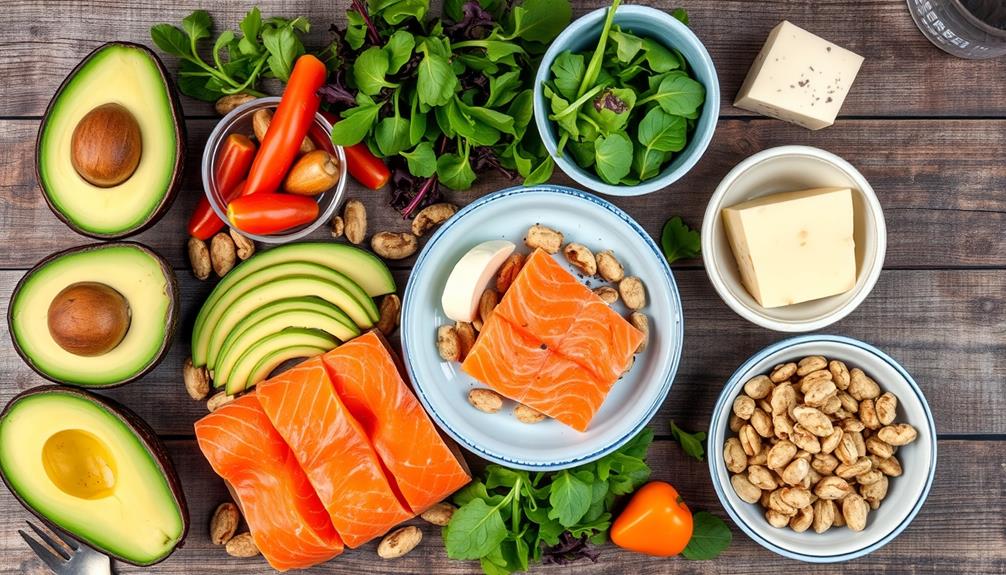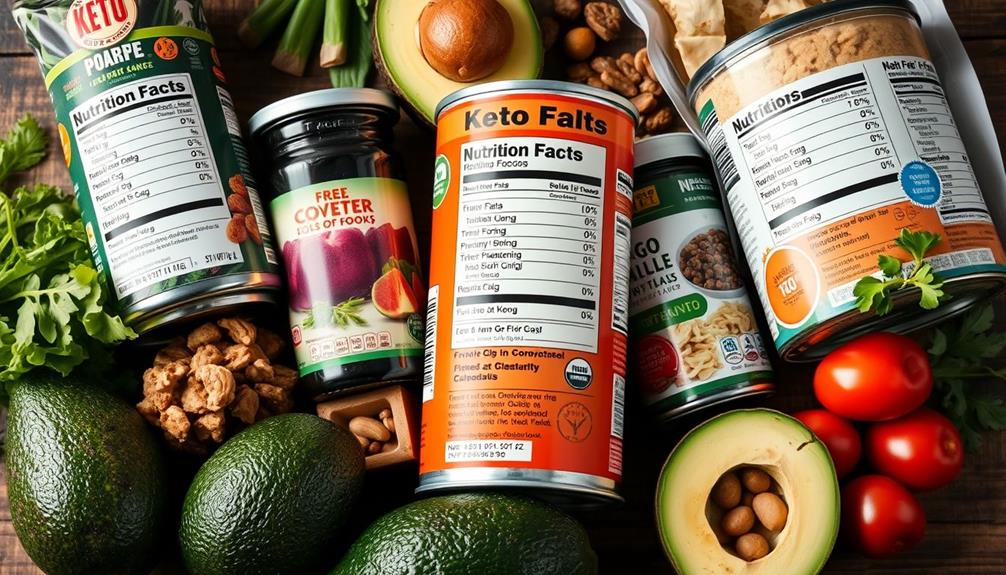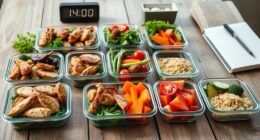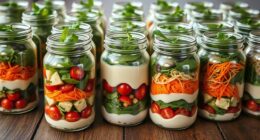To increase your electrolyte levels on a keto diet, start by adding salt to your meals. Incorporate nutrient-rich foods like bone broth, leafy greens such as spinach, and low-carb fruits like avocados. Snack on nuts and seeds for extra magnesium and potassium. Don't forget to include keto-friendly fish like salmon and electrolyte-rich meats such as chicken and pork. If you're active or sweat a lot, consider using sugar-free electrolyte supplements for a quick boost. These simple strategies can help you maintain balance effortlessly. There's plenty more you can do to optimize your diet and health!
Key Takeaways
- Add salt to meals using table salt, sea salt, or bouillon to boost sodium intake between 2,000 to 4,000 mg daily.
- Incorporate nutrient-rich foods like bone broth, leafy greens, nuts, seeds, and keto-friendly fish to enhance electrolyte levels.
- Use sugar-free electrolyte supplements to quickly replenish sodium and potassium, especially after exercise or sweating.
- Replace high-carb fruits with low-carb options like avocados, strawberries, and cucumbers for additional potassium and magnesium.
- Snack on mixed nuts and seeds for a tasty way to increase electrolyte intake while maintaining low-carb goals.
Add Salt to Your Food

Adding salt to your food is essential when you're on a keto diet, especially since it helps replenish important electrolytes like sodium and chloride. On a low-carb diet, your body tends to excrete more sodium due to lower insulin levels, which can lead to electrolyte imbalances.
To prevent dehydration and maintain fluid balance, you should aim for a daily sodium intake of 2,000 to 4,000 mg. Keeping track of your budget can also help you manage costs associated with health foods and supplements that support your diet.
Don't hesitate to add salt to your meals; it not only enhances flavor but also keeps your sodium levels in check. You can easily incorporate sodium through table salt, sea salt, or by adding bouillon, pickles, and salty snacks.
These simple choices can help you effectively replenish electrolytes that might be lost on a keto plan.
However, it's important to consult a healthcare professional before greatly increasing your sodium intake, especially if you have any underlying health conditions.
Discover Bone Broth

Bone broth is a nutrient-rich superfood that packs a punch with essential electrolytes like sodium, potassium, and magnesium.
Its high nutrient content can help support hydration levels while on a keto diet, which is vital for maintaining overall health.
You can easily incorporate it into your meals, whether you sip it plain or use it as a base for soups and stews.
By adding bone broth to your keto diet, you not only enhance flavor but also boost your overall wellness.
Additionally, it's important to monitor your electrolyte intake, especially if you're experiencing gastrointestinal issues from other dietary changes, as seen with juice diets.
Nutrient-Rich Superfood Benefits
Here are some benefits of adding bone broth to your diet:
- Rich in Collagen: Supports healthy hair, nails, and joints.
- Electrolyte Boost: Provides essential sodium, potassium, and magnesium, crucial for hydration and muscle function, especially when on a ketogenic diet. Incorporating bone broth can also complement other essential oils for hydration that support overall wellness.
- Keto-Friendly: Fits perfectly into your low-carb meal plan.
- Hydration Aid: Helps keep you hydrated, especially during the keto shift.
Opting for organic, keto-friendly bone broth options makes it easy to enjoy this superfood daily.
Versatile Culinary Uses
Incorporating bone broth into your meals brings a wealth of flavor and nutrition to your table. This nutrient-rich superfood is perfect for those on a keto diet, as it's packed with essential electrolytes like sodium, potassium, calcium, magnesium, and phosphorus. By regularly consuming bone broth, you can effectively replenish electrolytes, supporting hydration and overall health on a low-carb diet.
Additionally, the benefits of using natural ingredients, like bone broth, can complement your diet and enhance your wellness routine, especially when considering air quality considerations that affect overall health.
One of the most appealing aspects of bone broth is its versatility. You can sip it plain for a warming drink or use it as a flavorful base for soups, stews, and sauces. This not only enhances the taste of your dishes but also boosts their nutritional value. When making a hearty soup, for instance, substituting water with bone broth can transform a simple recipe into a rich, fulfilling meal.
Plus, with organic and keto-friendly options readily available, it's easy to incorporate bone broth into various culinary uses. Whether you're cooking a comforting stew or creating a delicious sauce, this versatile ingredient supports your keto lifestyle while delivering the hydration and nutrients you need.
Embrace bone broth and elevate your meals while nourishing your body!
Incorporate Leafy Greens

To boost your electrolyte intake on a keto diet, adding leafy greens like spinach, kale, and romaine lettuce to your meals is a smart choice. These greens are packed with essential nutrients, helping you maintain electrolyte balance while keeping carbs low.
For instance, spinach offers around 334 mg of potassium per 100 grams, making it a great option for meeting your daily potassium needs of 2-3 grams. Incorporating leafy greens can also provide benefits similar to natural remedies alongside conventional medications that may support overall health.
Incorporating leafy greens into your meals can enhance your nutrient intake without compromising your keto lifestyle. Here are some easy ways to include them:
- Toss spinach into your morning smoothie for a nutrient boost.
- Create a vibrant salad using kale, topped with your favorite keto-friendly dressing.
- Sauté romaine lettuce with garlic and olive oil for a quick side dish.
- Add chopped greens to your omelet for extra flavor and nutrients.
Regularly consuming these leafy greens not only supports your potassium, calcium, and magnesium levels but can also help alleviate symptoms of keto flu, making your adjustment to low-carb eating smoother.
Include Nuts and Seeds

Nuts and seeds are great nutrient-dense snacks that can boost your electrolyte levels on a keto diet.
Incorporating foods that support kidney health is essential, and when you choose options like pecans, almonds, and chia seeds, you not only keep your carb count low but also add essential minerals to your meals.
These nutrient-rich snacks can also help with effective strategies for weight loss by offering healthy fats and proteins.
Incorporating these foods into your daily routine makes it easy to enhance your overall health while enjoying tasty treats.
Nutrient-Dense Snack Options
A variety of nutrient-dense snacks can help you boost your electrolyte levels while sticking to a keto diet. Incorporating nuts and seeds into your daily routine is an excellent way to achieve this. These snacks aren't only low in carbs but also packed with essential nutrients like magnesium and potassium, vital for maintaining electrolyte balance.
Additionally, some herbal teas, like ginger and chamomile, may also provide relaxation benefits while supporting overall health during your nutritional journey—best herbal tea for period pain.
Here are some great options to take into account:
- Almonds: Around 80 mg of magnesium per ounce.
- Pumpkin seeds: Rich in both magnesium and potassium.
- Chia seeds: Packed with healthy fats and electrolytes; perfect for smoothies.
- Macadamia nuts: High in fat and contain about 200 mg of potassium per ounce.
Snacking on a mix of these nutrient-dense snacks can help you meet your magnesium and calcium needs while keeping your carb intake low.
Plus, you can even find chocolate-covered nuts for a sweet treat that still aligns with your keto diet. By incorporating these snacks throughout your day, you'll support your overall nutritional adequacy and keep your electrolyte levels in check.
Best Keto-Friendly Choices
When you're on a keto diet, choosing the right snacks can greatly impact your electrolyte levels. Nuts and seeds are fantastic keto-friendly options that not only satisfy your cravings but also boost your magnesium and potassium intake. For instance, just one ounce of almonds provides about 80 mg of magnesium, while pumpkin seeds pack a whopping 150 mg per ounce.
Incorporating mastering the art of bug out bags can also help you prepare nutrient-dense snacks for emergencies, ensuring you maintain your electrolyte balance even in challenging situations.
Pecans, walnuts, and macadamia nuts are excellent picks, offering healthy fats alongside essential electrolytes, making them ideal snacks for maintaining electrolyte balance. You can also enhance your nutrient intake with chia and hemp seeds; chia seeds deliver approximately 111 mg of magnesium and 44 mg of potassium per ounce.
Incorporating a handful of mixed nuts or seeds into your day can greatly raise your electrolyte levels without compromising your low-carb goals. These snacks aid in hydration and help maintain an overall nutrient balance on your keto journey.
Incorporating Into Meals
Incorporating nuts and seeds into your meals is an excellent way to boost your electrolyte intake while staying true to your keto goals. These foods aren't only delicious but also packed with essential minerals, making them a smart choice for health-conscious eaters.
To make sure you're getting enough magnesium daily, focus on incorporating a variety of nuts and seeds into your diet. Additionally, experimenting with different brewing methods can enhance your overall enjoyment of coffee, which can also serve as a delightful pairing with your keto-friendly snacks.
- Add a handful of chia seeds to your smoothies or yogurt for a magnesium and fiber boost.
- Top your salads with hemp seeds, providing magnesium and potassium without significant carbs.
- Snack on a mix of walnuts and almonds to enhance your potassium and magnesium levels while enjoying healthy fats.
- Use almond or peanut butter in your meals or snacks for a tasty source of electrolytes.
Eat Keto-Friendly Fish

Eating keto-friendly fish is a delicious way to boost your electrolyte intake while enjoying flavorful meals. Options like salmon, sardines, mackerel, and trout aren't only tasty but also packed with essential nutrients.
These fish can serve as a hedge against nutritional deficiencies, similar to how Gold IRAs provide stability in financial portfolios. For instance, a 3-ounce serving of salmon delivers about 326 mg of potassium and 20 mg of magnesium, making it a solid choice for replenishing your electrolytes.
Sardines, often found canned, provide around 351 mg of calcium and 247 mg of potassium per 3-ounce serving. This combination supports bone health and muscle function, reducing the risk of muscle cramps.
Incorporating these fatty fish into your diet also adds omega-3 fatty acids, which are vital for heart health and fighting inflammation.
Replace High-Carb Fruits

To maintain balanced electrolytes on a keto diet, it's important to replace high-carb fruits with lower-carb options. High-carb fruits like bananas can lead to electrolyte loss, while low-carb fruits provide essential nutrients such as potassium and magnesium.
By making simple swaps, you can enjoy whole foods that support your health and hydration.
Consider these healthy options:
- Avocados: Packed with only 2 grams of net carbs, they're rich in potassium and magnesium.
- Berries: Strawberries and raspberries contain about 6-7 grams of carbs per 100 grams and are loaded with antioxidants.
- Cucumbers: These invigorating veggies have about 4 grams of carbs per 100 grams and provide hydration while contributing to your electrolyte intake.
- Unsweetened Coconut: With around 6 grams of carbs per 100 grams, it's high in healthy fats and offers potassium and magnesium.
Incorporating lemon or lime juice can also enhance your meals with minimal carbs while providing vitamin C.
Choose Electrolyte-Rich Meats
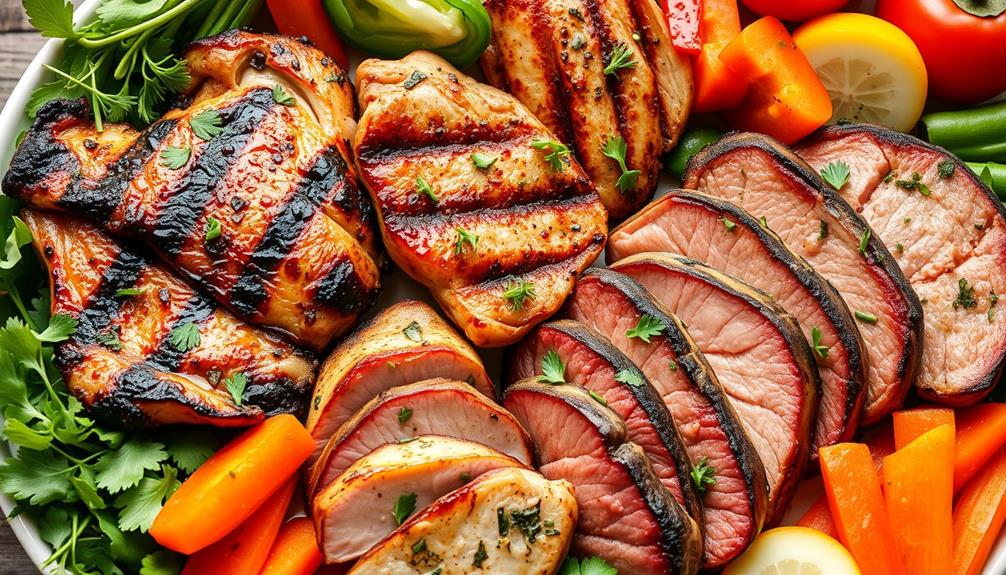
Choosing electrolyte-rich meats can greatly boost your mineral intake while following a keto diet. These meats, like chicken, pork, turkey, and various cuts of red meat, are packed with essential minerals such as potassium, magnesium, and sodium.
For instance, a 3-ounce serving of chicken breast offers about 332 mg of potassium, while pork provides around 379 mg. Red meats, like sirloin steak, also contribute to your intake, containing approximately 315 mg of potassium and added sodium.
Incorporating a variety of these electrolyte-rich meats into your meals not only enhances flavor but also promotes nutrient diversity, ensuring you get a well-rounded intake of electrolytes.
This is particularly important during the initial stages of the keto diet when you're at a higher risk of deficiencies. Regularly consuming these meats helps maintain your electrolyte balance, essential for overall health and well-being.
Utilize Electrolyte Supplements

When you're on a keto diet, don't overlook the power of electrolyte supplements to help you stay balanced. These supplements are essential for replenishing your electrolytes, especially during the initial phases when you're adjusting to lower carb intake.
Sugar-free electrolyte powders, like LMNT and High 5 Zero, can be conveniently mixed with water, providing hydration and essential nutrients without added carbs.
Here are some benefits of utilizing electrolyte supplements:
- Quick replenishment of sodium and potassium to combat muscle weakness.
- Helps mitigate keto flu symptoms like headaches and muscle cramps.
- Convenient to use, as smaller doses taken with meals enhance absorption.
- Ideal for those with increased physical activity or high sweat loss.
Frequently Asked Questions
How to Replenish Electrolytes on Keto?
To replenish electrolytes on keto, focus on increasing your sodium, potassium, and magnesium intake. Add salt to meals, eat potassium-rich foods like avocados, and include nuts for magnesium to balance your levels effectively.
What Are Good Electrolytes for Keto?
Oh sure, just grab a magic wand and summon electrolytes! But really, for keto, you need sodium, potassium, and magnesium. Think salt, avocados, and nuts—your new best friends on this low-carb adventure!
How Do You Know if You Have Low Electrolytes on Keto?
You'll know you have low electrolytes on keto if you experience symptoms like headaches, fatigue, muscle cramps, irritability, or heart palpitations. Tracking your intake can help prevent these issues from affecting your daily life.
What Is the Fastest Way to Replenish Electrolytes?
Imagine a parched desert; you need that revitalizing oasis. To replenish electrolytes fast, munch on avocados, sip bone broth, or grab a sugar-free electrolyte drink. Your body's thirst for balance will be quenched swiftly.
Conclusion
You might think cutting carbs is the only key to success on a keto diet, but don't overlook the importance of electrolytes. By adding salt to your meals, enjoying bone broth, and incorporating leafy greens, you can keep your body balanced and energized. Remember, skipping out on electrolytes can lead to fatigue and cravings. So, make sure you're fueling your body right, and you'll discover how much better you can feel on your keto journey!


